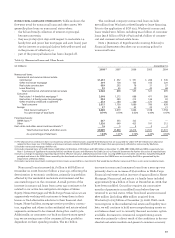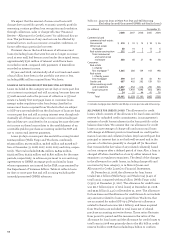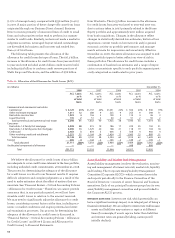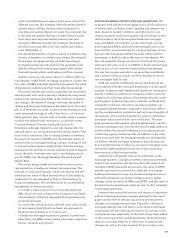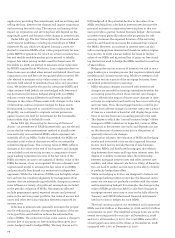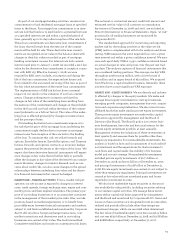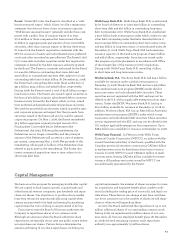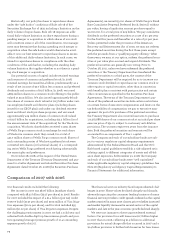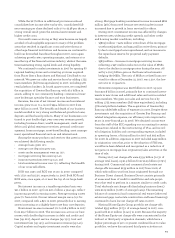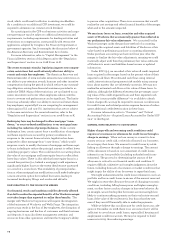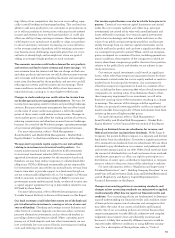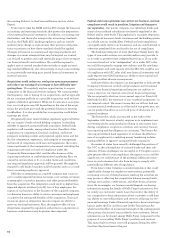Wells Fargo 2008 Annual Report Download - page 74
Download and view the complete annual report
Please find page 74 of the 2008 Wells Fargo annual report below. You can navigate through the pages in the report by either clicking on the pages listed below, or by using the keyword search tool below to find specific information within the annual report.
Changes in equity market prices may also indirectly affect
our net income by affecting (1) the value of third party assets
under management and, hence, fee income, (2) particular bor-
rowers, whose ability to repay principal and/or interest may
be affected by the stock market, or (3) brokerage activity,
related commission income and other business activities.
Each business line monitors and manages these indirect risks.
LIQUIDITY AND FUNDING The objective of effective liquidity
management is to ensure that we can meet customer loan
requests, customer deposit maturities/withdrawals and other
cash commitments efficiently under both normal operating
conditions and under unpredictable circumstances of industry
or market stress. To achieve this objective, Corporate ALCO
establishes and monitors liquidity guidelines that require
sufficient asset-based liquidity to cover potential funding
requirements and to avoid over-dependence on volatile, less
reliable funding markets. We set these guidelines for both the
consolidated balance sheet and for the Parent to ensure that
the Parent is a source of strength for its regulated, deposit-
taking banking subsidiaries.
Debt securities in the securities available-for-sale portfolio
provide asset liquidity, in addition to the immediately liquid
resources of cash and due from banks and federal funds sold,
securities purchased under resale agreements and other
short-term investments. The weighted-average expected
remaining maturity of the debt securities within this portfolio
was 5.2 years at December 31, 2008. Of the $155.2 billion (cost
basis) of debt securities in this portfolio at December 31, 2008,
$49.9 billion (32%) is expected to mature or be prepaid in 2009
and an additional $21.7 billion (14%) in 2010. Asset liquidity is
further enhanced by our ability to sell or securitize loans in
secondary markets and to pledge loans to access secured bor-
rowing facilities through the Federal Home Loan Banks, the
Federal Reserve Board, or the U.S. Treasury. In 2008, we sold
mortgage loans of $218 billion. The amount of mortgage loans
and other consumer loans available to be sold, securitized or
pledged was approximately $230 billion at December 31, 2008.
Core customer deposits have historically provided a size-
able source of relatively stable and low-cost funds. Average
core deposits funded 53.8% and 58.2% of average total assets
in 2008 and 2007, respectively.
The remaining assets were funded by long-term debt
(including trust preferred securities), certain other deposits,
and short-term borrowings (federal funds purchased, securi-
ties sold under repurchase agreements, commercial paper
and other short-term borrowings). Long-term debt averaged
$102.3 billion in 2008 and $93.2 billion in 2007. Short-term
borrowings averaged $65.8 billion in 2008 and $25.9 billion in
2007, an increase of $39.9 billion due to business funding needs.
We anticipate making capital expenditures of approximately
$2.8 billion in 2009 for our stores, relocation and remodeling
of our facilities, and routine replacement of furniture, equipment
and servers. We fund expenditures from various sources,
including cash flows from operations and borrowings.
Liquidity is also available through our ability to raise
funds in a variety of domestic and international money and
capital markets. We access capital markets for long-term
funding through issuances of registered debt securities, pri-
vate placements and asset-backed secured funding. Rating
agencies base their ratings on many quantitative and qualita-
tive factors, including capital adequacy, liquidity, asset quality,
business mix, and level and quality of earnings. Material
changes in these factors could result in a different debt rat-
ing; however, a change in debt rating would not cause us to
violate any of our debt covenants. At February 23, 2009,
Wells Fargo Bank, N.A. has the highest credit rating currently
given to U.S. banks by Moody’s Investors Service, “Aa1,” and
Standard & Poor’s Rating Services, “AA+.”
Table 22 provides the credit ratings of the Company,
Wells Fargo Bank, N.A. and Wachovia Bank, N.A. as of
February 23, 2009.
funds in noninterest bearing transaction accounts at FDIC
insured institutions. Under the Debt Guarantee Program, we
have $91.7 billion of remaining capacity to issue guaranteed
debt as of December 31, 2008. Eligible entities will be assessed
fees payable to the FDIC for coverage under the program. This
assessment will be in addition to risk-based deposit insurance
assessments currently imposed under FDIC rules and regulations.
Table 22: Credit Ratings
Wells Fargo & Company Wells Fargo Bank, N.A. Wachovia Bank, N.A.
Senior Subord- Commer- Long- Short- Long- Short-
debt inated cial term term term term
debt paper deposits borrow- deposits borrow-
ings ings
Moody’s Aa3 A1 P-1 Aa1 P-1 Aa1 P-1
S&P AA AA- A-1+ AA+ A-1+ AA+ A-1+
Fitch, Inc. AA AA- F1+ AA+ F1+ AA+ F1+
DBRS AA AA*R-1** AA*** R-1*** AA*** R-1***
*low ** middle *** high
Wells Fargo is participating in the Federal Deposit
Insurance Corporation’s (FDIC) Temporary Liquidity
Guarantee Program (TLGP). The TLGP has two components:
the Debt Guarantee Program, which provides a temporary
guarantee of newly issued senior unsecured debt issued by
eligible entities; and the Transaction Account Guarantee
Program, which provides a temporary unlimited guarantee of





